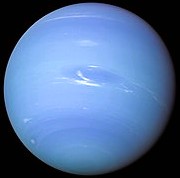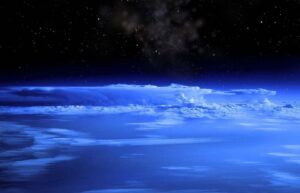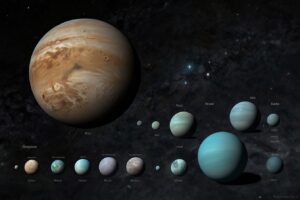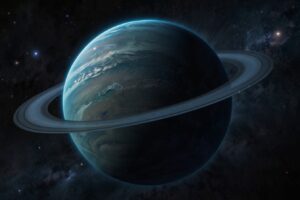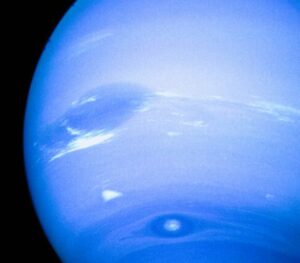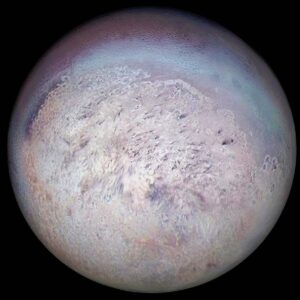- abaashishb7
- April 13, 2024
- 10:37 am
- No Comments
Neptune Planet
वरुण ग्रह
* Unveiling Neptune’s Mysteries: What Lies Beneath the Blue
Neptune is the eighth and farthest known planet from the Sun in the Solar System. It is
a gas giant, similar in composition to Uranus. Neptune is the fourth-largest planet by
diameter and the third-largest by mass. It is named after the Roman god of the sea
due to its blue color, which is caused by the methane in its atmosphere. Neptune has a
turbulent atmosphere with high-speed winds and large storms, including the famous
Great Dark Spot. It has a system of rings and a total of 14 known moons, the largest of
which is Triton. Neptune was discovered in 1846 by the French astronomer Urbain Le
Verrier.
* The discovery of Neptune
The discovery of Neptune is an intriguing tale in the history of astronomy, which
involved a combination of mathematical predictions and observational discoveries.
Here is a summary of how Neptune was discovered
Early Observations and Prediction
1:- Anomalies in Uranus’ Orbit:
In the early 19th century, astronomers noticed that the planet Uranus was not
following its predicted path exactly. The discrepancies between the observed and
predicted positions of Uranus suggested that there might be another planet beyond
Uranus, which was tugging on it with its gravitational pull.
2:- Mathematical Predictions:
Two mathematicians, Urbain Le Verrier in France and John Couch Adams in
England, independently began working on calculations to predict the position of the
hypothetical planet. Le Verrier, using mathematical calculations based on
perturbations in Uranus’ orbit, sent his predictions to Johann Gottfried Galle at the
Berlin Observatory in Germany. Adams, working separately, also arrived at a similar
predictions for the position of the unseen planet.
Discovery by Johann Gottfried Galle
1:- Observational Confirmation:
Using Le Verrier’s calculations on September 23, 1846, Johann Gottfried Galle and
his assistant Heinrich d’Arrest observed Neptune at the Berlin Observatory. Galle
found Neptune within one degree of Le Verrier’s predicted location in the sky,
confirming its existence. The discovery of Neptune was essentially a triumph of
celestial mechanics and mathematical prediction.
2:- Simultaneous Discovery:
Interestingly, while Galle was the first to observe Neptune based on Le Verrier’s
predictions, a few days earlier, on September 18, 1846, the English astronomer
John Couch Adams had sent his predictions to the Cambridge Observatory.
Unfortunately, due to delays and other factors, Adams’ predictions were not acted
upon in time for him to be credited with the discovery. Thus, the discovery of
Neptune is typically attributed to Galle, based on Le Verrier’s calculations.
Naming Neptune
1:- Naming the New Planet:
The newly discovered planet was initially referred to as “Le Verrier’s planet” or “the
new star” before it was officially named Neptune. The name Neptune was
suggested by Le Verrier himself, after the Roman god of the sea, due to the
planet’s deep blue color and its position far from the Sun.
Significance
1:- Scientific Impact:
The discovery of Neptune not only confirmed the power of mathematical
predictions in astronomy but also provided further evidence for the gravitational
theory of planetary motion. It also completed the sequence of planets in our solar
system, at least until the discovery of Pluto much later.
* Dimension Of Neptune
Diameter
1:- Equatorial Diameter: Approximately 49,244 kilometers (30,598 miles)
2:- Polar Diameter: Approximately 48,340 kilometers (30,020 miles)
3:- Average Diameter: About 49,244 kilometers (30,598 miles)
Neptune is the fourth-largest planet in our solar system by diameter, following Jupiter,
Saturn, and Uranus.
Circumference
The circumference of Neptune at its equator is roughly 155,600 kilometers
(96,800 miles).
Surface Area
The total surface area of Neptune is estimated to be approximately 7.618 × 10^9
square kilometers (2.941 × 10^9 square miles).
Neptune is a gas giant similar to Uranus, consisting mainly of hydrogen, helium, and
traces of other compounds. Its dimensions make it one of the largest planets in our
solar system, with a diameter just slightly smaller than that of Uranus.
* Key Fact of Neptune
Distance from the Sun
1:- Average Distance from the Sun: Approximately 4.5 billion kilometers
(2.8 billion miles)Neptune is the farthest known planet from the Sun.
Orbital Period
1:- Orbital Period (Year): Approximately 164.8 Earth years
Neptune takes about 164.8 Earth years to complete one orbit around the Sun.
Day Length
1:- Day Length (Rotation Period): Approximately 16.1 hours
Neptune rotates on its axis relatively quickly, completing one rotation in about 16.1
Earth hours.
Size
1:- Equatorial Diameter: Approximately 49,244 kilometers (30,598 miles)
Neptune is the fourth-largest planet in our solar system by diameter.
Gravity
1:- Surface Gravity: Approximately 11.15 meters per second squared (m/s²)
This is about 1.14 times the gravity on Earth’s surface.
Appearance
Neptune has a deep blue color, which is due to the presence of methane in its
atmosphere.
The blue color of Neptune is similar to Uranus, but it appears more vibrant due to
differences in atmospheric composition.
Surface Features
Neptune, like the other gas giants, does not have a solid surface. Its “surface” is a layer
of gas and ice.
The planet’s atmosphere is marked by dynamic weather patterns, including high-speed
winds and large storms.
Atmosphere
1:- Composition: Neptune’s atmosphere is primarily composed of hydrogen (H2),
helium (He), and methane (CH4).
Methane in the atmosphere gives Neptune its blue color, as it absorbs red light and
reflects blue light.
The atmosphere also contains traces of other compounds, such as water (H2O),
ammonia (NH3), and hydrocarbons.
Magnetic Field
Neptune has a strong magnetic field, tilted at an angle of about 47 degrees relative to
its axis of rotation.
The magnetic field is thought to be generated by a dynamo process within its deep
layers, similar to Earth’s magnetic field.
Moons
Neptune has 14 known moons, but the most notable is Triton, which is the seventh-
largest moon in the solar system.
Triton is unique among the large moons in that it orbits Neptune in a retrograde
direction, opposite to the planet’s rotation.
Other major moons of Neptune include Proteus, Nereid, Larissa, and Despina.
* Composition Of Neptune
Atmosphere
This Planet’s atmosphere is predominantly composed of:
1:- Hydrogen (H2): The most abundant element in the atmosphere, making up about
80% by volume.
2:- Helium (He): The second most abundant gas, comprising about 19% of the
atmosphere.
3:- Methane (CH4): Present in smaller quantities but responsible for the planet’s
distinct blue color. Methane absorbs red light and reflects blue light, giving This
Planet has a vivid hue.
Traces of other compounds in the atmosphere include:
Water (H2O)
Ammonia (NH3)
Hydrocarbons
Other gases and ices
Interior
This Planet, like other gas giants, likely has a small rocky core at its center,
surrounded by layers of different materials.
The interior of This Planet is believed to consist of:
1:- Rocky Core: It is estimated to be about 1.2 times Earth’s mass, composed of
silicates and metals.
2:- Icy Mantle: Above the core, there is likely a mantle layer of water, ammonia, and
methane ices.
3:- Gaseous Envelope: The outermost layer is the thick gaseous envelope, mainly
hydrogen and helium with traces of methane and other gases.
Trace Elements
Besides the major components mentioned above, This Planet’s composition also
includes traces of:
Carbon Monoxide (CO) and Carbon Dioxide (CO2)
Nitrogen (N2) and Nitrogen Compounds
Sulfur Compounds
Methane and Color
The presence of methane in This Planet’s atmosphere is crucial for its blue coloration.
Methane absorbs red light wavelengths, reflecting blue light into space. This
gives This Planet its striking deep blue appearance.
Similarities to Uranus
This Planet’s composition is quite similar to Uranus, its neighboring ice giant.
Both planets are primarily composed of hydrogen, helium, and methane, with
differences in the exact proportions and trace elements.
Complexity and Variability
This Planet’s composition is not static; its atmosphere and interior may vary over time
due to dynamic processes.
The presence of various compounds and gases contributes to the dynamic weather
patterns and storms observed on This Planet, including the Great Dark Spot and other
atmospheric features.
* Structure Of Neptune
Core
This Planet likely has a small rocky core at its center, similar to the other gas giants.
The core is estimated to be about 1.2 times the mass of Earth and is composed of
silicates and metals.
Mantle
Above the rocky core is a layer known as the mantle.
The mantle of This Planet is thought to consist of water, ammonia, and methane ices.
This layer is under tremendous pressure due to the weight of the layers above it.
Gaseous Envelope
The outermost layer of This Planet is its thick gaseous envelope, which makes up the
majority of the planet’s volume.
The gaseous envelope consists mainly of hydrogen (about 80%) and helium (about
19%), similar to the composition of Jupiter and Saturn.
Traces of methane in the atmosphere give This Planet its distinct blue color.
Atmosphere
The atmosphere of This Planet is a dynamic and turbulent layer of gases.
It is primarily composed of hydrogen, helium, and methane.
Methane in This Planet’s atmosphere absorbs red light and reflects blue light, giving
the planet its characteristic blue color.
The atmosphere also contains traces of other compounds such as water, ammonia,
and hydrocarbons.
Weather and Storms
This Planet’s atmosphere is known for its dynamic weather patterns and storms.
The most famous storm on This Planet is the Great Dark Spot, which is similar to
Jupiter’s Great Red Spot but with a darker color.
Other features include bright clouds, dark spots, and high-speed winds, some reaching
up to 2,100 kilometers per hour (1,300 miles per hour).

Magnetic Field
This Planet has a strong magnetic field, tilted at an angle of about 47 degrees relative
to its axis of rotation.
The magnetic field is generated by a dynamo process within its deep layers, similar to
Earth’s magnetic field.
This magnetic field interacts with charged particles from the solar wind, creating
auroras near the planet’s poles.
Rings and Moons
This Planet has a faint ring system, consisting of five main rings, though they are not
as prominent as Saturn’s.
The planet has 14 known moons, with Triton being the largest and most notable. Triton
is also unique among large moons as it orbits This Planet in a retrograde direction.
* What Would Happen if a Human Were to Enter Neptune?
Entering This Planet would be an incredibly dangerous and fatal endeavor for a human
due to its extreme environment. Here’s what would happen if a human were somehow
able to enter This Planet:
Extreme Cold
This Planet is the farthest planet from the Sun, which means it receives very little
sunlight.
The average temperature on This Planet is about -214 degrees Celsius (-353 degrees
Fahrenheit).
This extreme cold would quickly freeze any human or equipment, leading to immediate
death.
Pressure
This Planet’s atmosphere is incredibly thick and dense.
The pressure at the level where the atmosphere becomes 1 bar (similar to Earth’s sea
level pressure) is about 1,000 times greater than Earth’s.
The immense pressure would crush a human body almost instantly.
Lack of Oxygen
This Planet’s atmosphere is primarily composed of hydrogen and helium, with traces
of methane and other gases.
The atmosphere lacks the oxygen needed for humans to breathe.
A human would suffocate within seconds due to the absence of breathable air.
Toxicity
The methane in This Planet’s atmosphere is toxic to humans.
Exposure to methane would be harmful, causing respiratory and other health issues
even before the extreme cold and pressure take effect.
Wind Speeds
This Planet has incredibly strong winds, reaching speeds of up to 2,100 kilometers per
hour (1,300 miles per hour).
These winds would easily overpower and toss around any human or object attempting
to enter the atmosphere.
if a human were somehow able to enter This Planet’s atmosphere, they would be
exposed to extreme cold, crushing pressure, lack of oxygen, toxic gases, and
incredibly high wind speeds. Death would be nearly instantaneous, making it
impossible for a human to survive on or inside This Planet.
* Unique Characteristics of Neptune
Ice Giant
This Planet is classified as an ice giant, along with Uranus. These planets are distinct
from gas giants like Jupiter and Saturn due to their higher proportions of “ices”
(compounds such as water, ammonia, and methane) in their composition.
Vibrant Blue Color
One of the most striking features of This Planet is its deep blue color, which is the result
of the absorption of red light by methane in the atmosphere.
Methane absorbs red light and reflects blue light, giving This Planet its distinct hue.
The planet’s blue appearance is enhanced by the presence of other atmospheric
compounds.
Dynamic Weather
This Planet’s atmosphere is marked by dynamic and turbulent weather patterns.
The planet experiences high-speed winds, some reaching up to 2,100 kilometers per
hour (1,300 miles per hour).
The Great Dark Spot, a massive storm similar to Jupiter’s Great Red Spot, was
observed in This Planet’s atmosphere.
Other features include bright clouds, dark spots, and a constantly changing
appearance.
The Great Dark Spot
The Great Dark Spot was a large, dark storm observed in This Planet’s atmosphere.
Similar to Jupiter’s Great Red Spot, it was a massive anticyclonic storm system.
The Great Dark Spot was first observed by the Voyager 2 spacecraft during its flyby in
1989.
However, subsequent observations with the Hubble Space Telescope revealed that the
Great Dark Spot had disappeared, indicating the dynamic nature of This Planet’s
atmosphere.
Rings
This Planet has a faint ring system, though it is not as prominent as Saturn’s.
The rings are composed of dust particles, rock fragments, and ice.
These rings were first discovered in 1984 during observations from Earth and later
confirmed by Voyager 2.
Triton
Triton is This Planet’s largest moon and one of the most unusual in the solar system.
It is the only large moon in the solar system with a retrograde orbit, meaning it orbits
This Planet is in the opposite direction of the planet’s rotation.
Triton’s orbit is highly inclined, and it is believed to be a captured Kuiper Belt object.
The moon is geologically active, with cryovolcanism (volcanic activity involving water
and ammonia) and a thin atmosphere.
Magnetic Field
This Planet has a strong magnetic field, similar to those of the other gas giants.
However, its magnetic field is tilted at an angle of about 47 degrees relative to its axis
of rotation, making it one of the most tilted magnetic fields in the solar system.
This unique tilt indicates complex interactions between the planet’s magnetic field and
its interior.
Distant Orbit
This Planet is the farthest known planet from the Sun, located at an average distance
of about 4.5 billion kilometers (2.8 billion miles).
Its orbit takes approximately 164.8 Earth years to complete, making it a distant and
cold world.
These unique characteristics make This Planet a fascinating and enigmatic planet,
providing valuable insights into the diversity of worlds in our solar system. Ongoing
studies and potential future missions aim to further explore and understand the
mysteries of this distant ice giant.
* Modern Exploration of Neptune
Neptune has been the subject of exploration primarily through robotic spacecraft, with the most notable mission being NASA’s Voyager 2. Here is an overview of the modern exploration of Neptune:

Voyager 2 Mission
1:- Launch and Flyby:
Voyager 2 was launched by NASA on August 20, 1977, and its primary mission was
to study the outer planets of our solar system.
On August 25, 1989, Voyager 2 made its closest approach to Neptune, becoming
the first and only spacecraft to visit the planet.
2:- Discoveries:
Voyager 2 provided a wealth of data and discoveries about Neptune, its moons,
rings, and atmosphere.
It confirmed the existence of Neptune’s faint rings, discovered six new moons
(bringing the total to 8 known moons at the time), and observed the planet’s
dynamic atmosphere.
3:- Great Dark Spot:
Voyager 2’s images revealed the presence of a large, dark storm in Neptune’s
atmosphere, known as the Great Dark Spot.
This storm was similar in size and appearance to Jupiter’s Great Red Spot but with
a darker color.
4:- Triton:
Voyager 2 captured detailed images and data of Neptune’s largest moon, Triton.
It discovered geysers erupting from Triton’s surface, indicating cryovolcanism
(volcanic activity involving ice).
Triton’s unique characteristics, such as its retrograde orbit and thin atmosphere,
were also studied.
5:- Atmospheric Data:
Voyager 2’s instruments provided valuable data on the composition and dynamics
of Neptune’s atmosphere.
It confirmed the presence of methane in the atmosphere, which gives Neptune its
distinct blue color.
Wind speeds and cloud patterns were also observed and studied.
Hubble Space Telescope (HST)
1:- Continued Observations:
The Hubble Space Telescope (HST) has been instrumental in studying This Planet
since Voyager 2’s flyby.
Hubble has captured images of This Planet’s changing weather patterns, including
cloud formations and storms.
2:- Changes in Atmosphere:
Hubble observations have revealed changes in This Planet’s atmosphere, such as
the disappearance of the Great Dark Spot observed by Voyager 2.
The telescope continues to monitor the planet for any new atmospheric
phenomena.
Ground-Based Observations
1:- Observatories:
Earth-based observatories have also contributed to the ongoing study of This
Planet.
Telescopes around the world have been used to observe This Planet’s changing
cloud patterns, atmospheric composition, and moon system.
Future Exploration
1:- Proposed Missions:
There have been discussions and proposals for future missions to This Planet,
including orbiters and landers.
These missions aim to further explore This Planet’s moons, rings, and atmosphere,
providing more detailed data than what was obtained by Voyager 2.
2:- International Collaboration:
Future missions to This Planet would likely involve international collaboration, as
seen with previous planetary exploration missions.
This Planet has been primarily explored by the Voyager 2 spacecraft, providing
valuable data and discoveries about the planet, its moons, rings, and atmosphere.
Continued observations by the Hubble Space Telescope and ground-based
observatories contribute to our understanding of This Planet’s dynamic and ever-
changing environment. Future missions are being proposed to further explore this
distant ice giant and unlock more of its mysteries.
- abaashishb7
- April 13, 2024
- 10:37 am
- No Comments


